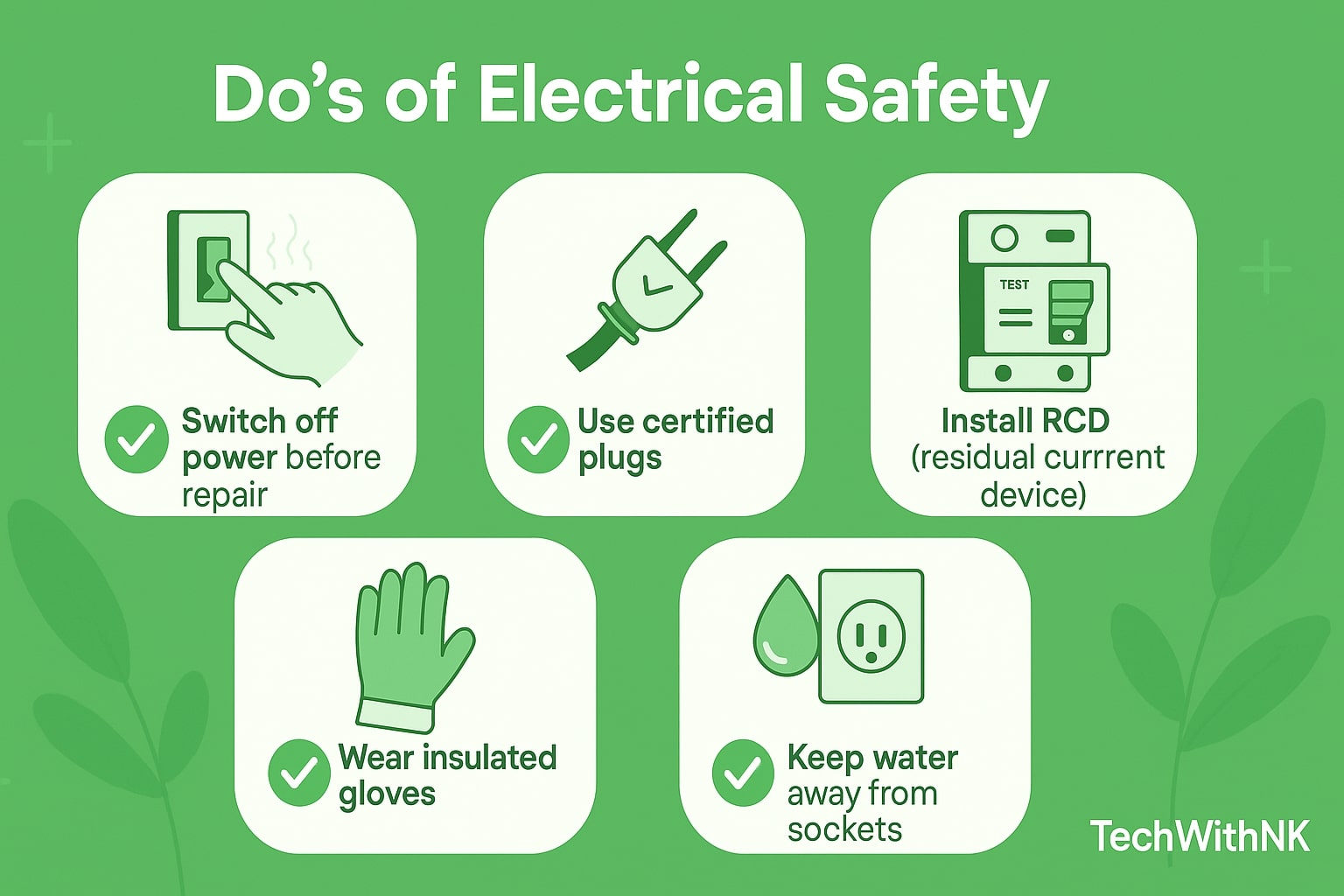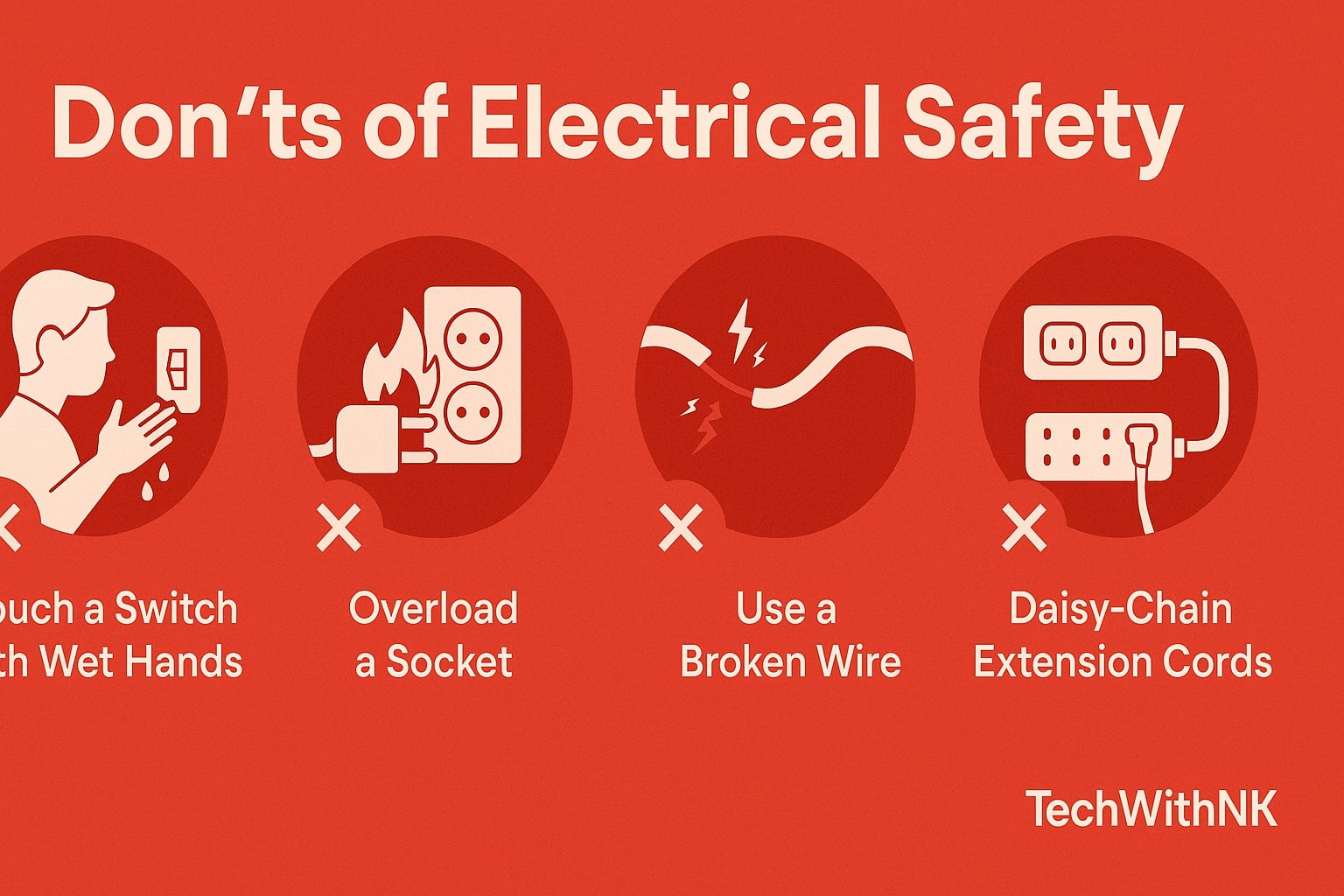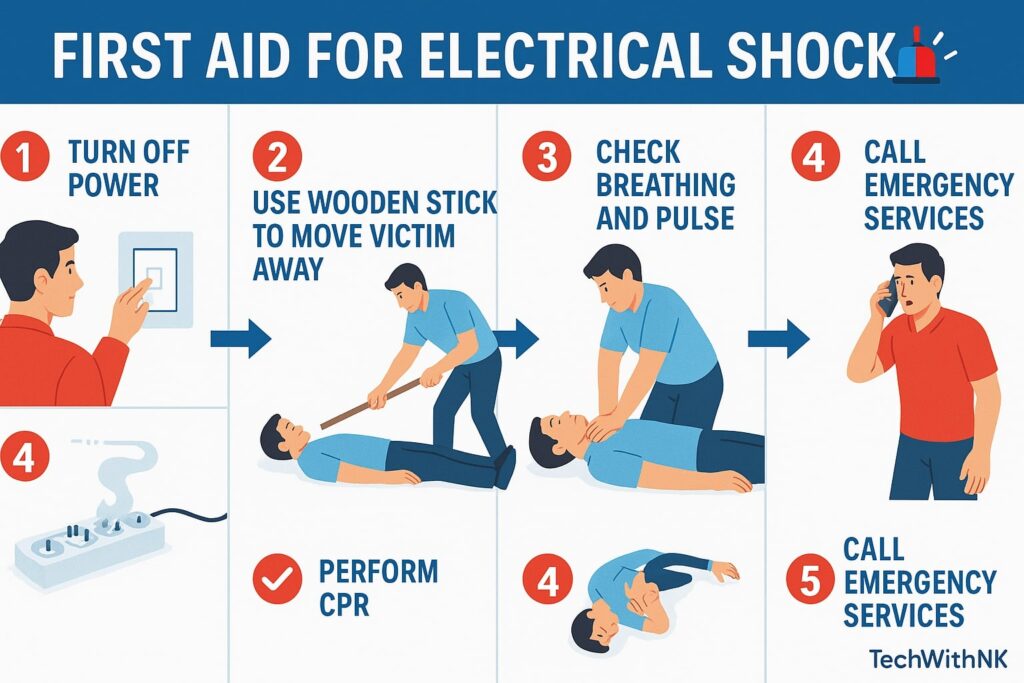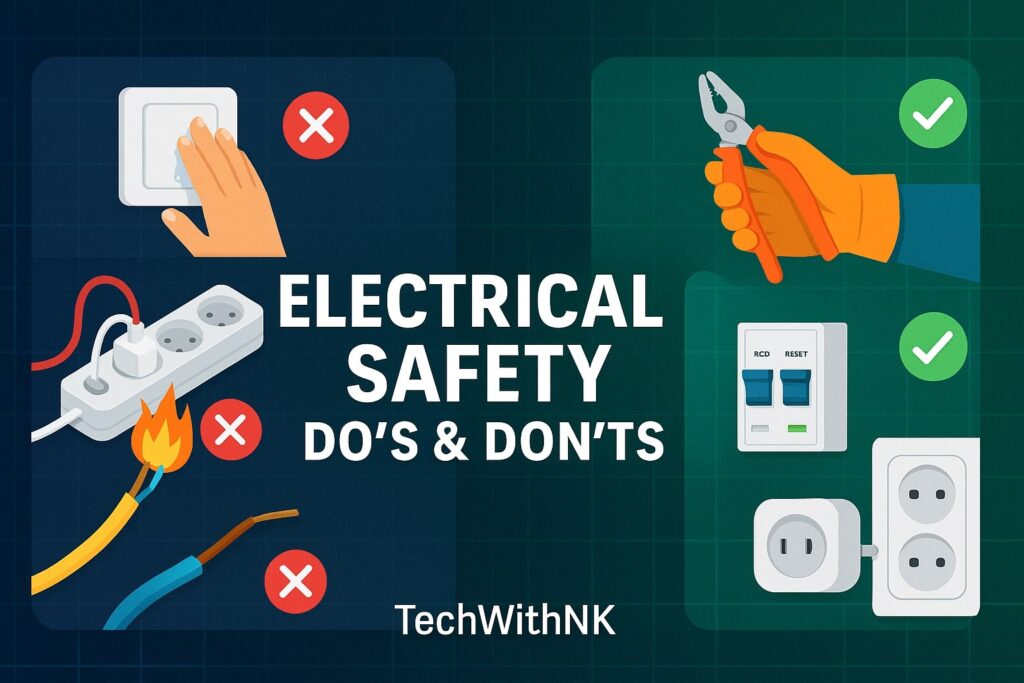Introduction: Why Electrical Safety Matters
Electricity has become so deeply integrated into our lives that we often take it for granted. We switch on the lights, charge our phones, run our washing machines, and power entire industries without thinking twice about the invisible force flowing through wires. Yet this same electricity that lights up our world can also take lives in a fraction of a second if not handled with care.
According to global safety reports, electrical accidents cause tens of thousands of injuries and fires every year. In India alone, the National Crime Records Bureau (NCRB) reported more than 7,000 deaths annually due to electrocution and electrical fires. These numbers are not just statistics—they represent preventable tragedies caused by negligence, lack of awareness, or ignorance of safety rules.
For beginners—whether you are a homeowner, a student experimenting with circuits, or someone just starting your career in electrical engineering—understanding electrical safety is not optional, it is essential. This blog will serve as a comprehensive guide to the do’s and don’ts of electrical safety, explained in detail with examples, so you can develop safe habits and protect yourself and others.
Basics of Electricity for Beginners
Before we dive into safety, let’s refresh the basic concepts of electricity.
Voltage, Current, and Power Explained
Voltage (V) is like the pressure of water in a pipe. The higher the pressure, the harder it pushes the current through.
Current (I) is the actual flow of electrons, like water flowing through a pipe. It’s measured in amperes (A).
Resistance (R) is the opposition to current flow, like the pipe’s size restricting water flow.
Power (P) is how much energy is consumed:
P=V×I
A common misconception is that only high voltage kills. In reality, current is the real danger. Even 30 milliamps (0.03 A) passing through the human body can stop the heart.
Household Supply
In India: 230V AC, 50Hz
In the USA: 120V AC, 60Hz
This means every time you touch a live wire at home, you are dealing with voltages that are more than enough to cause serious harm.
Why Electricity is Dangerous
The danger lies in its invisibility. Unlike fire, electricity doesn’t produce a smell or visible warning before striking. It can silently pass through your body, damaging nerves, muscles, and the heart in milliseconds. The human body, being a good conductor, becomes part of the circuit if it touches a live source.
Case Study: In 2022, a young student in Delhi was electrocuted while charging his mobile phone in the bathroom where the floor was wet. This tragic accident highlights why even routine activities can become deadly when basic safety is ignored.
Common Electrical Hazards at Home and Workplace
Many electrical hazards hide in plain sight:
Overloaded Sockets – Plugging too many appliances into one outlet causes overheating, leading to fires.
Damaged Wires – A small crack in insulation can expose live wires, creating a shock or fire risk.
Water Near Electricity – Kitchens and bathrooms are common danger zones. Wet surfaces conduct electricity faster.
Improper Earthing (Grounding) – Without proper grounding, any fault current can pass through the body instead of safely discharging into the earth.
Loose Connections – Loose plugs or switches spark and generate heat, eventually igniting fires.
Example: In many households, people use a single multi-plug strip for TV, fridge, computer, and washing machine. This is a recipe for disaster because high-power appliances demand their own outlets.

General Do’s of Electrical Safety
Switch Off Before Touching
Always turn off the main switch before attempting to repair or replace anything electrical. This single step can save your life.
Use Certified Appliances
Buy electrical equipment with ISI, CE, or UL certification. These marks show the product has been tested for safety.
Keep Water Away
Never use hairdryers, mobile chargers, or heaters near sinks or bathtubs. Bathrooms are the most common sites for fatal shocks.
Regular Maintenance
Inspect your home wiring every 5–10 years. Replace old aluminum wiring with copper and check for corroded connections.
Install Protective Devices
Residual Current Devices (RCDs) or Earth Leakage Circuit Breakers (ELCBs) immediately cut off power if they detect leakage current—saving lives within milliseconds.

General Don’ts of Electrical Safety
Don’t Overload
Plugging a heater, microwave, and refrigerator into the same extension cord is a fire hazard. Each heavy appliance needs a dedicated line.
Don’t Touch with Wet Hands
Even a simple act like turning on a light switch with wet hands can cause a lethal shock.
Don’t Use Cheap Products
Counterfeit chargers, low-quality switches, and uncertified extension cords are leading causes of fires.
Don’t Ignore Warning Signs
If you smell burning plastic, see sparks, or hear crackling sounds from a socket, switch off immediately and call an electrician.
Safe Handling of Electrical Appliances
Appliances are convenient, but unsafe use can turn them deadly.
Always read the manufacturer’s manual.
Never pull cords to unplug; hold the plug firmly.
Keep appliances away from children’s reach.
Unplug devices like irons, kettles, and heaters after use.
Do not wrap cords tightly—they may overheat and crack.
Real-life story: In Mumbai, a washing machine caught fire because the plug was left on even when the appliance wasn’t running. A simple habit of switching off could have prevented this.
Extension Cords & Power Strips: Do’s and Don’ts
Extension cords are convenient but misused more than any other device.
✅ Do use: surge-protected strips for sensitive electronics like laptops.
❌ Don’t use: extension cords for heaters, irons, or microwaves—they draw too much current.
Running cords under carpets seems tidy, but it’s dangerous. The wires heat up and may burn unnoticed until it’s too late.
Child Safety and Electricity
Lorem ipsum dolor sit amet, consectetur ad
Children are naturally curious, and that curiosity can lead to tragic accidents.
Install child-proof socket covers.
Keep appliances like kettles, irons, and chargers out of reach.
Educate children: Tell them electricity is not a toy.
Don’t let them play near electrical panels or substations.
ipiscing elit. Ut elit tellus, luctus nec ullamcorper mattis, pulvinar dapibus leo.
Workplace Electrical Safety Guidelines
Workplaces, especially factories and power plants, deal with higher voltages than homes.
Lockout/Tagout (LOTO): Before maintenance, power sources must be locked and tagged to prevent accidental switching.
Insulated Tools: Workers should use screwdrivers, pliers, and cutters with insulated handles.
Training: Every employee should know emergency procedures and evacuation plans.
Distance: Maintain a minimum clearance from live wires.
Outdoor Electrical Safety
During storms, stay indoors and avoid touching electrical poles or wires.
Fallen power lines should be reported immediately. Stay at least 10 meters away.
Use only outdoor-rated extension cords for gardening or outdoor lighting.
Never attempt to cut branches near overhead power lines.
DIY Electrical Work: What Beginners Should Avoid
Many beginners try DIY electrical fixes after watching online tutorials. But electricity is not forgiving.
Never attempt to open main distribution panels.
Don’t bypass fuses or breakers—they exist for your protection.
Avoid rewiring circuits without training.
Tip: Beginners should limit themselves to safe tasks like changing bulbs, plugging devices, or using tested extension cords. Leave complex jobs to licensed electricians.
Protective Devices and Their Role
Circuit Breakers
They trip and cut off supply during overloads or short circuits.
Fuses
They melt when current exceeds a safe limit, acting as a sacrificial protector.
RCD/ELCB
Detect leakage current (like when electricity flows through the human body) and disconnect the supply instantly.
Personal Protective Equipment (PPE)
When working with electricity:
Wear rubber-soled shoes.
Use insulated gloves.
Stand on an insulating mat.
Use flame-resistant clothing in industrial setups.

First Aid in Case of Electrical Shock
Switch Off Power: Never touch the victim until the current is cut.
Remove with Insulator: Use wood, plastic, or rubber to separate them from the source.
Check Breathing and Pulse: If absent, start CPR.
Call Emergency Services Immediately.
Case Studies of Electrical Accidents
Case 1: A Fire from Overloaded Socket (Delhi, 2021). A family plugged a heater and fridge into the same strip. The socket overheated and caused a night fire. Lesson: Never overload.
Case 2: Worker Electrocuted in Power Plant. Maintenance done without lockout/tagout killed an electrician. Lesson: Always isolate power.
Modern Innovations in Electrical Safety
Technology is making electricity safer:
Smart Circuit Breakers: Send phone alerts when tripped.
Arc Fault Detection Devices (AFDD): Detect sparks before fire starts.
Smart Plugs: Auto-switch off if overheating.
Conclusion
Electricity is a faithful servant but a dangerous master. By following these detailed do’s and don’ts, you can eliminate most risks. Beginners must remember that safety is not just about protecting oneself—it’s about protecting your family, your property, and your workplace. Stay alert, invest in quality equipment, and never underestimate electricity.











